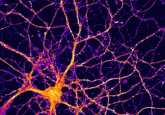Prion protein interactions and memory in Parkinson’s disease

For decades, researchers have looked to α-synuclein to help uncover the cause of—and hopefully pinpoint a treatment for—Parkinson’s disease and its related cognitive symptoms. New evidence now suggests that prion protein interactions may be at the root at the disorder’s memory and cognitive deficits.
Parkinson’s disease is best known for its hallmark motor symptoms, such as muscle tremors, weakness, and slowed movements. It results from a build-up of the protein α-synuclein in the brain—particularly in the substantia nigra, an area of the brain critical to movement control. But the disorder also profoundly affects memory and cognition. Tiago Outeiro, a neuroscientist from Germany’s University Medical Center Goettingen, said that researchers have been at a loss to explain why.
“We know that α-synuclein does not just build up in the substantia nigra; there is a lot of it hanging around in other parts of the brain,” he said. “So we decided to look at the hippocampus, the area of the brain that is important to memory formation and cognition, to see if perhaps there might be some α-synuclein floating around outside the neurons and if it might somehow be affecting synaptic plasticity.”
Previous work showed that cellular prion protein (PrPC) mediated α-synuclein-related dysfunction in the brain and that it significantly decreased the magnitude of long-term potentiation (LTP), a key indicator of synaptic strength. So Outeiro and his colleagues decided to compare electrophysiological recordings from hippocampal slices of PrPC-null mice and wild-type controls in the presence of extracellular α-synuclein.
The team discovered that the interaction of α-synuclein and PrPC significantly impaired LTP. When they looked further into the cascade of processes causing this change by using antibodies to block PrPC, they saw that extracellular α-synuclein formed a complex with PrPC at the post-synaptic density , ultimately dysregulating the cell’s calcium homeostasis. Despite this deficit, the researchers rescued the dampening of LTP by adding a small caffeine analogue to the cells. The results were published in the November 2017 issue of Nature Neuroscience and were also presented at Neuroscience 2017, the 47th annual Society for Neuroscience meeting held in Washington, D.C.
“We know that α-synuclein is spreading around in the brain. So if we know that it is spreading, this means, at some point, there’s going to be protein floating around in other parts of the brain outside of the neurons. That seemed to us that it should be a problem,” said Outeiro. “Now we’ve found that, indeed, it causes quite a bit of dysfunction by activating some signaling cascades that eventually lead to alterations in synaptic plasticity. We believe this translates into issues with the process of memory formation—which is probably quite important in the context of Parkinson’s disease related cognitive deficits—and offers us new avenues to pursue treatments for memory-related symptoms.”





